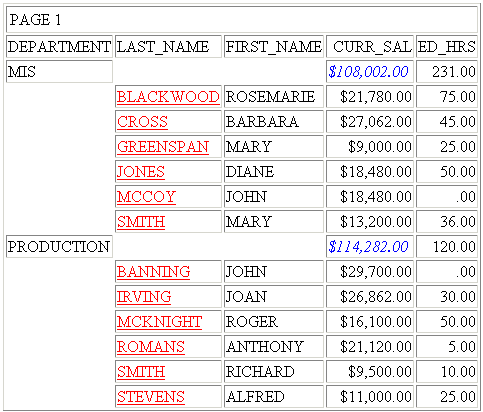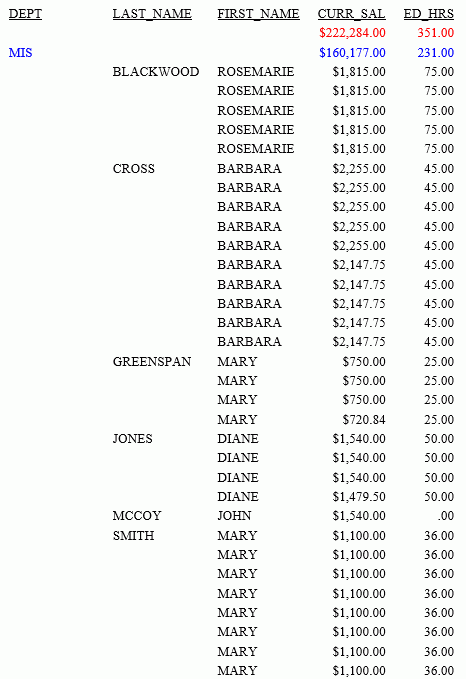Controlling Formatting of Reports With Multiple Display Commands
|
How to: |
You can use the SET DUPLICATECOL command to reformat report requests that use multiple display commands, placing aggregated fields in the same column above the displayed field.
By default, each new display command in a request generates additional sort field and display field columns. With DUPLICATECOL set to OFF, each field occupies only one column in the request, with the values from each display command stacked under the values for the previous display command.
Syntax: How to Control the Format of Reports With Multiple Display Commands
SET DUPLICATECOL={ON|OFF} where:
- ON
-
Displays the report with each field as a column. This is the default value.
- OFF
-
Displays the report with common fields as a row.
Example: Displaying Reports With Multiple Display Commands
The following request sums current salaries and education hours for the entire EMPLOYEE data source and for each department:
TABLE FILE EMPLOYEE SUM CURR_SAL ED_HRS SUM CURR_SAL ED_HRS BY DEPARTMENT END
With DUPLICATECOL=ON, the output has separate columns for the grand totals and for the departmental totals:
CURR_SAL ED_HRS DEPARTMENT CURR_SAL ED_HRS
-------- ------ ---------- -------- ------
$222,284.00 351.00 MIS $108,002.00 231.00
PRODUCTION $114,282.00 120.00 With DUPLICATECOL=OFF, the output has one column for each field. The grand totals are on the top row of the report, and the departmental totals are on additional rows below the grand totals:
DEPARTMENT CURR_SAL ED_HRS
---------- -------- ------
$222,284.00 351.00
MIS $108,002.00 231.00
PRODUCTION $114,282.00 120.00 The following request adds a PRINT command sorted by department and by last name to the previous request:
SET SPACES = 1 TABLE FILE EMPLOYEE SUM CURR_SAL ED_HRS SUM CURR_SAL ED_HRS BY DEPARTMENT AS 'DEPT' PRINT FIRST_NAME CURR_SAL ED_HRS BY DEPARTMENT BY LAST_NAME END
With DUPLICATECOL=ON, the output has separate columns for the grand totals, for the departmental totals, and for each last name:

With DUPLICATECOL=OFF, the output has one column for each field. The grand totals are on the top row of the report, the departmental totals are on additional rows below the grand totals, and the values for each last name are on additional rows below their departmental totals:
DEPT LAST_NAME FIRST_NAME CURR_SAL ED_HRS
---- --------- ---------- -------- ------
$222,284.00 351.00
MIS $108,002.00 231.00
BLACKWOOD ROSEMARIE $21,780.00 75.00
CROSS BARBARA $27,062.00 45.00
GREENSPAN MARY $9,000.00 25.00
JONES DIANE $18,480.00 50.00
MCCOY JOHN $18,480.00 .00
SMITH MARY $13,200.00 36.00
PRODUCTION $114,282.00 120.00
BANNING JOHN $29,700.00 .00
IRVING JOAN $26,862.00 30.00
MCKNIGHT ROGER $16,100.00 50.00
ROMANS ANTHONY $21,120.00 5.00
SMITH RICHARD $9,500.00 10.00
STEVENS ALFRED $11,000.00 25.00 Syntax: How to Style a Report With SET DUPLICATECOL=ON
In a StyleSheet, you can identify the rows you want to style by specifying which display command created those rows:
VERBSET = n
where:
- n
-
Is the ordinal number of the display command in the report request.
Example: Styling Rows Associated With a Specific Display Command
The following request has two display commands:
- SUM CURR_SAL ED_HRS BY DEPARTMENT (totals by department).
- PRINT FIRST_NAME CURR_SAL ED_HRS BY DEPARTMENT BY LAST_NAME (values by employee by department).
SET DUPLICATECOL = OFF TABLE FILE EMPLOYEE SUM CURR_SAL ED_HRS BY DEPARTMENT PRINT FIRST_NAME CURR_SAL ED_HRS BY DEPARTMENT BY LAST_NAME ON TABLE HOLD FORMAT HTML ON TABLE SET STYLE * TYPE = REPORT, COLUMN= P4, VERBSET = 1, STYLE = ITALIC, COLOR=BLUE,$ TYPE = REPORT, COLUMN= B2, VERBSET = 2, STYLE = UNDERLINE, COLOR = RED,$ ENDSTYLE END
On the output:
- The fourth displayed column (P4, department total of CURR_SAL) for the SUM command is italic and blue.
- The second BY field (LAST_NAME) for the PRINT command is underlined and red.
When you style specific columns, using P notation means that you count every column that displays on the report output, including BY columns. Therefore, P1 is the DEPARTMENT column, P2 is the LAST_NAME column (this is also B2, the second BY field column), P3 is the FIRST_NAME column, P4 is the displayed version of the CURR_SAL column (the internal matrix has multiple CURR_SAL columns), and P5 is the displayed ED_HRS column (the internal matrix has multiple ED_HRS columns).
The output is:

Reference: Stacking Duplicate Columns in Multi-Verb Requests Based on AS Names
You can use the SET DUPLICATECOL command to reformat report requests that use multiple display commands, placing aggregated fields in the same column above the displayed field.
By default, each new display command in a request generates additional sort field and display field columns. With DUPLICATECOL set to OFF, each field occupies only one column in the request, with the values from each display command stacked under the values for the previous display command.
In prior releases, the duplicate columns were matched based on field names. Now, fields can also be matched based on AS names. An AS name will not be matched to a field name. When a field has an AS name, it will only be matched to other fields that have the same AS name.
Example: Stacking Duplicate Columns in Multi-Verb Requests Based on AS Names
The following request has three display commands. The first sums the CURR_SAL field. The second sums the SALARY field by department. The third prints the GROSS field by department and last name. Each field is assigned the same AS name, even the CURR_SAL field.
TABLE FILE EMPLOYEE SUM CURR_SAL AS CURR_SAL ED_HRS SUM SALARY AS CURR_SAL ED_HRS BY DEPARTMENT AS 'DEPT' PRINT FIRST_NAME GROSS AS CURR_SAL ED_HRS BY DEPARTMENT BY LAST_NAME ON TABLE SET DUPLICATECOL OFF ON TABLE SET PAGE NOLEAD ON TABLE SET STYLE * GRID=OFF, SIZE=10, $ VERBSET=1, COLOR=RED,$ VERBSET=2, COLOR=BLUE,$ VERBSET=3,COLOR=BLACK,$ ENDSTYLE END
The partial output is shown in the following image.
